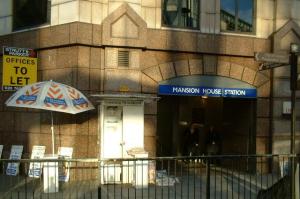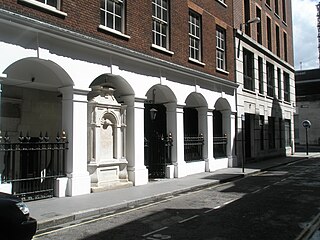Related Research Articles
Alexander Brome was an English poet.
The Dean of the Arches is the judge who presides in the provincial ecclesiastical court of the Archbishop of Canterbury. This court is called the Arches Court of Canterbury. It hears appeals from consistory courts and bishop's disciplinary tribunals in the province of Canterbury.

St Leonard, Foster Lane, was a Church of England church dedicated to Leonard of Noblac on the west side of Foster Lane in the Aldersgate ward of the City of London. It was destroyed in the Great Fire of 1666 and not rebuilt.

St Mary Bothaw was a parish church in the Walbrook ward of the City of London. It was destroyed in the Great Fire of London in 1666 and not rebuilt, although some of its materials were used in the rebuilding of St Swithin, London Stone, whose parish it was merged with.

St Nicholas Acons was a parish church in the City of London. In existence by the late 11th century, it was destroyed during the Great Fire of London of 1666 and not rebuilt.

All-Hallows-the-Less was a church in the City of London. Of medieval origin, it was destroyed in the Great Fire of London in 1666 and not rebuilt.

St Andrew Hubbard was a parish church in the Billingsgate ward of the City of London. It was destroyed in the Great Fire of London in 1666, and not rebuilt.

Holy Trinity the Less was a parish church in Knightrider Street in the City of London, destroyed in the Great Fire of London. Following the fire the site was used for a Lutheran church, which was eventually demolished in 1871 to make way for Mansion House underground station.

St Botolph's, Billingsgate was a Church of England parish church in London. Of medieval origin, it was located in the Billingsgate ward of the City of London and destroyed by the Great Fire of London in 1666.

St Gabriel Fenchurch was a parish church in the Langbourn Ward of the City of London, destroyed in the Great Fire of London and not rebuilt.

St John the Baptist upon Walbrook was a parish church in the City of London. It stood in Walbrook Ward, with parts of the parish extending into Cordwainer, Dowgate and Vintry Wards. Of medieval origin, it was destroyed in the Great Fire of London in 1666 and not rebuilt.

The church of St Margaret Moses stood on the east side of Friday Street in the Bread Street ward of the City of London. It was destroyed in the Great Fire of London of 1666 and not rebuilt.

St Mary Mounthaw or Mounthaut was a parish church in Old Fish Street Hill in the City of London. Of medieval origin, it was destroyed in the Great Fire of London in 1666 and not rebuilt.

St Michael-le-Querne, also called St Michael ad Bladum, was a parish church in the Farringdon Within Ward in the City of London. It was destroyed in the Great Fire of London of 1666 and not rebuilt.

St Pancras, Soper Lane, was a parish church in the City of London, in England. Of medieval origin, it was destroyed in the Great Fire of London in 1666 and not rebuilt.

St Martin Pomeroy was a parish church in the Cheap ward of the City of London. It was also known as St Martin Ironmonger Lane.

St Laurence Pountney was a parish church in the Candlewick Ward of the City of London. It was destroyed in the Great Fire of London of 1666, and not rebuilt.

St. Leonard, Eastcheap, sometimes referred to as St Leonard Milkchurch, was a parish church in the City of London. Of medieval origin, it was destroyed in the Great Fire of London in 1666 and not rebuilt. The site of the church was retained as a graveyard.

Edward Waddington (1670?–1731) was an English prelate, bishop of Chichester from 1724 to 1731.
Sir Robert Chichele was a 15th-century English merchant and Lord Mayor of London.
References
- 1 2 3 4 5 6 "NEWCOURT, Richard (d 1716)". AIM25. Retrieved 7 January 2013.
- ↑ Cust, Lionel Henry (1894). "Newcourt, Richard (d.1679)". In Lee, Sidney (ed.). Dictionary of National Biography . 40. London: Smith, Elder & Co.
- 1 2 3 Goodwin, Gordon (1894). "Newcourt, Richard (d.1716)". In Lee, Sidney (ed.). Dictionary of National Biography . 40. London: Smith, Elder & Co.
- ↑ Newcourt, Richard (1708). Repertorium Ecclesiasticum Parochiale Londinense. 1. London. p. 440.
- ↑ The court was held at the church of St Mary-le-bow until its destruction by the Great Fire in 1666, was transferred temporarily to Exeter House in the Strand, and then to Doctors' Commons.
- ↑ Jenkinson, Wilberforce (1917). London Churches Before the Great Fire. London: Society for the Promotion of Christian Knowledge. p. vi.
- ↑ Lysons, Daniel (1796). The Environs of London: volume 4: Counties of Herts, Essex & Kent. pp. 426–493. Retrieved 27 January 2013.